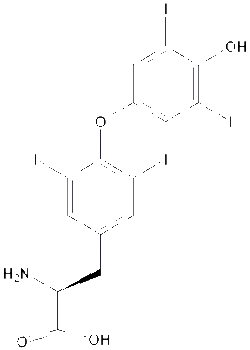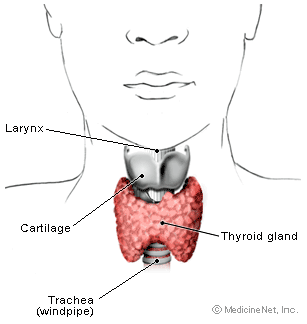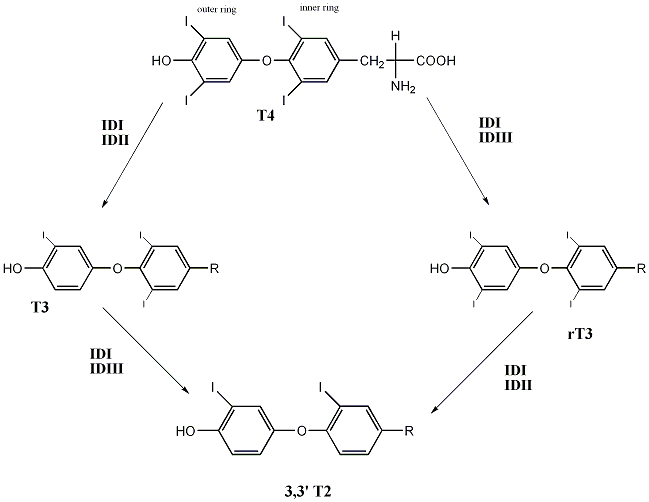Levothyroxine
Levothyroxine, otherwise known as L-thyroxine, synthetic T4 or 3,5,3',5'-tetraiodo-L-thyronine, is a synthetic form of thyroxine, which is the key hormone secreted by the follicular cells of the thyroid gland. Both the naturally occuring hormone of T4 and the synthetic form exists in the L-form.
Other common brand names include ""Thyrax"", "Euthyrox", "Levaxin" and "Eltroxin" in Europe, as well as "Levoxyl" and "Synthroid" in the U.S.
|
Cyclopentasiloxane |
| Properties of Levothyroxine | |
|---|---|

| |
| IUPAC Systematic name | |
| 3,5,3',5'-Tetraiodo-L-thyronine | |
| Other name | |
| Euthyrox, Levaxin, Eltroxin, Levoxyl, Synthroid&btnG=Google+Search&meta= Thyrax, Euthyrox, Levaxin, Eltroxin, Levoxyl, Synthroid | |
| Indentifiers | |
| ATC Code | H03AA01 |
| CAS number | {{{CASNo}}} |
| PubChem (CID) | 853 |
| SMILES | [C@@H(C(O)=O)N)C=C2I)=CC(I)=C1O IC1=CC(OC2=C(I)C=C(C[C@@H](C(O)=O)N)C=C2I)=CC(I)=C1O] |
| Chemical Data | |
| Molecular formula | C15H10I4NNaO4 |
| Molar mass | 798.86 g/mol (anhydrous) g/mol |
| Pharmacokinetic Data | |
| Bioavailability | approximately 100% |
| Protein Binding | {{{Protein_binding}}} |
| Metabolism | Mainly in liver, kidneys, bones and muscles |
| Half life | approximately 7 days in healthy human bodies, 3-4 days in hyperthyroidism, 9-10 days in hypothyroidism |
| Excretion | via faeces and urine |
| Therapeutic considerations | |
| Pregnancy cat. | A (FDA) |
| Legal status | Px (prescription only) |
| Routes | Oral, intravenous |
Thyroid hormone synthesis and secretion is regulated by the hypothalamic-pituitary-thyroid axis. Thyrotropin-releasing hormone (TRH) released from the hypothalamus stimulates secretion of thyrotropin-stimulating hormone, TSH, from the anterior pituitary,which in turn, is the physiologic stimulus for the synthesis and secretion of thyroid hormones, L-thyroxine (T4) and L-triiodothyronine (T3), by the thyroid gland. Circulating serum T3 and T4 levels exert a feedback effect on both TRH and TSH secretion. When serum T3 and T4 levels increase, TRH and TSH secretion decrease. When thyroid hormone levels decrease, TRH and TSH secretion increase.
The mechanisms by which thyroid hormones exert their physiologic actions are not completely understood, but it is thought that their principal effects are exerted through control of DNA transcription and protein synthesis. T3 and T4 diffuse into the cell nucleus and bind to thyroid receptor proteins attached to DNA. This hormone nuclear receptor complex activates gene transcription and synthesis of messenger RNA and cytoplasmic proteins.
Thyroid hormones regulate multiple metabolic processes and play an essential role in normal growth and development, and normal maturation of the central nervous system and bone. The metabolic actions of thyroid hormones include augmentation of cellular respiration and thermogenesis, as well as metabolism of proteins, carbohydrates and lipids. The protein anabolic effects of thyroid hormones are essential to normal growth and development.
The physiological actions of thyroid hormones are produced predominantly by T3, the majority of which (approximately 80%) is derived from T4 by deiodination in peripheral tissues.
Levothyroxine, at doses individualized according to patient response, is effective as replacement or supplemental therapy in hypothyroidism of any etiology, except transient hypothyroidism during the recovery phase of subacute thyroiditis.
Levothyroxine is also effective in the suppression of pituitary TSH secretion in the treatment or prevention of various types of euthyroid goiters, including thyroid nodules, Hashimoto's thyroiditis, multinodular goiter and, as adjunctive therapy in the management of thyrotropin-dependent well-differentiated thyroid cancer.
1. Absorption
Absorption of orally administered T4 from the gastrointestinal (GI) tract ranges from 40% to 80%. The majority of the Levothyroxine dose is absorbed from the jejunum and upper ileum. T4 absorption is increased by fasting, and decreased in malabsorption syndromes and by certain foods such as soybean infant formula. Dietary fiber decreases bioavailability of T4. Absorption may also decrease with age. In addition, many drugs and foods affect T4 absorption. (see Section on Precautions and Side effects)
2. Distribution
Circulating thyroid hormones are greater than 99% bound to plasma proteins, including thyroxine-binding globulin (TBG), thyroxine-binding prealbumin (TBPA), and albumin (TBA), whose capacities and affinities vary for each hormone. The higher affinity of both TBG and TBPA for T4 partially explains the higher serum levels, slower metabolic clearance, and longer half-life of T4 compared to T3. Protein-bound thyroid hormones exist in reverse equilibrium with small amounts of free hormone. Only unbound hormone is metabolically active. Many drugs and physiologic conditions affect the binding of thyroid hormones to serum proteins.
3. Metabolism
T4 is slowly eliminated. The major pathway of thyroid hormone metabolism is through sequential deiodination. Approximately eighty-percent of circulating T3 is derived from peripheral T4 by monodeiodination. The liver is the major site of degradation for both T4 and T3, with T4 deiodination also occurring at a number of additional sites, including the kidney and other tissues. Approximately 80% of the daily dose of T4 is deiodinated to yield equal amounts of T3 and reverse T3 (r T3). T3 and r T3 are further deiodinated to diiodothyronine. Thyroid hormones are also metabolized via conjugation with glucuronides and sulfates and excreted directly into the bile and gut where they undergo enterohepatic recirculation.
4. Elimination
Thyroid hormones are primarily eliminated by the kidneys. A portion of the conjugated hormone reaches the colon unchanged and is eliminated in the feces. Approximately 20% of T4 is eliminated in the stool. Urinary excretion of T4 decreases with age.
Levothyroxine is used to treat hypothyroidism, a condition where the thyroid gland fails to produce sufficient thyroid hormone. A body deficient in thyroid hormone cannot function properly, resulting in poor growth, slow speech, lack of energy, weight gain, hair loss, dry thick skin, and increased sensitivity to cold. When taken correctly, levothyroxine alleviates these symptoms. In addition, Levothyroxine is adminstered to treat congenital hypothyroidism (cretinism) and goiter (enlarged thyroid gland). Levothyroxine should not be used to treat weight and obesity problems.
The key objective of replacement therapy is to achieve and maintain a clinical and biochemical euthyroid state, whereas the aim of suppressive therapy is to inhibit growth and/or function of abnormal thyroid tissue. The dose of Levothyroxine that is adequate to achieve these goals depends on a variety of factors including the patient's age, body weight, cardiovascular status, concomitant medical conditions, including pregnancy, concomitant medications, and the specific nature of the condition being treated.Hence, the following recommendations serve only as dosing guidelines. Dosing must be individualized and adjustments made based on periodic assessment of the patient's clinical response and laboratory parameters.
Levothyroxine is administered as a single daily dose, preferably one-half to one-hour before breakfast or other meals to maximize its absorption. It is also recommended that the patient take the tablet with one glass of water to ease swallowing as well as to help the tablet dissolve for absorption. Also, Levothyroxine should be taken at least 4 hours apart from drugs that are known to interfere with its absorption.
Due to the long half-life of levothyroxine, the peak therapeutic effect at a given dose of levothyroxine sodium may not be attained for 4-6 weeks.
Caution should be exercised when administering Levothyroxine to patients with underlying cardiovascular disease, to the elderly, and to those with concomitant adrenal insufficiency.
It should be noted that there are also food and other substances that can interfere with absorption of thyroxine replacement. Calcium and iron supplements should not be consumed within four hours of the medication. Also, soy products should be avoided within three hours of the medication, since these can lower absorption of Levothyoxine.
Synthetic Levothyroxine may result in adverse side effects such as palpitations, nervousness, headache, difficulty sleeping, insomnia, swelling of the legs and ankles, weight loss and/or increased appetite. Some may be allergic to the medicine. If the patient develops a severe reaction to the drug like difficulty breathing, shortness of breath or swelling of the face and tongue, it the patient should stop consumption and seek medical attention as soon as possible.
Hyperthyroidism is a condition where an overactive thyroid gland produces an excessive amount of thyroid hormones, that circulate in the blood. ("Hyper" means "over" in Greek). Thyrotoxicosis is a toxic condition that is caused by an excess of thyroid hormones from any cause. Thyrotoxicosis can be caused by an excessive intake of thyroid hormone or by overproduction of thyroid hormones by the thyroid gland.
Hypothyroidism refers to any state where thyroid hormone production is below normal. There are many disorders that result in hypothyroidism. These disorders may directly or indirectly involve the thyroid gland. Since thyroid hormone affects growth, development, and many cellular processes, inadequate thyroid hormone has widespread consequences for the body.


